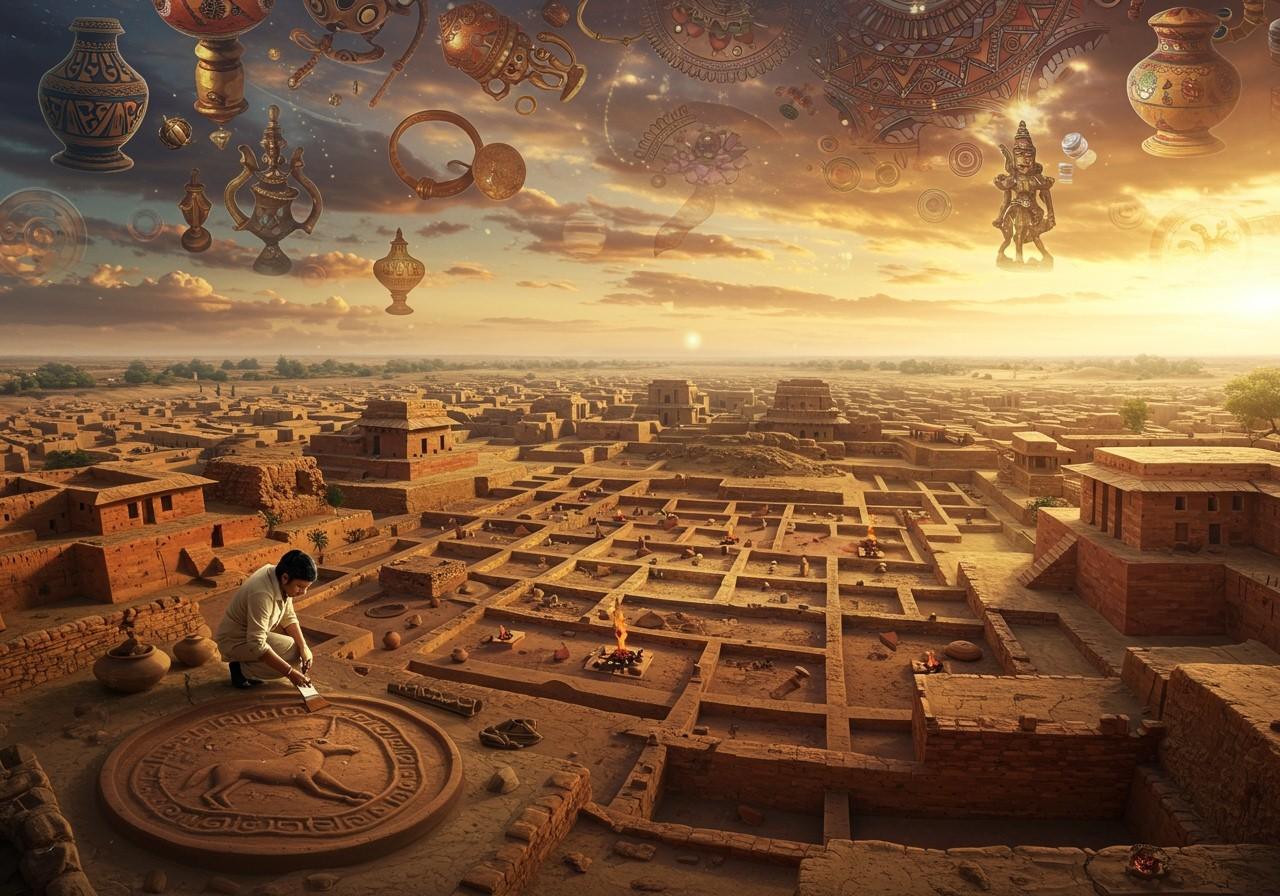
Kalibangan, a remarkable ancient city nestled in northern Rajasthan, India, offers a captivating glimpse into the flourishing Indus Valley Civilization. Discovered in 1953, this significant archaeological site has yielded invaluable insights into the early urban culture of the Harappan civilization. Kalibangan, meaning “black bangles,” a name derived from the abundance of terracotta bangles found there, stands as a testament to a sophisticated society that thrived thousands of years ago.
Unveiling the Past: Excavations at Kalibangan
The Archaeological Survey of India (ASI), spearheaded by archaeologists B.B. Lal and B.K. Thapar, commenced extensive excavations at Kalibangan in 1961. These meticulous excavations revealed a meticulously planned city, characterized by a fortified citadel and a lower residential town, showcasing the advanced urban planning of the Indus Valley people. The site provides evidence of both pre-Harappan and Harappan cultures, illuminating the transition between these periods.
Remarkable Discoveries: Insights into Indus Valley Life
The excavations at Kalibangan unearthed a treasure trove of artifacts and structures, shedding light on the daily lives, cultural practices, and intricate social structures of the Indus Valley inhabitants:
- Grid-patterned layout: The city’s well-defined grid layout demonstrates advanced urban planning, with streets intersecting at right angles, indicative of a structured and organized society. This sophisticated urban design facilitated efficient movement and organization within the city.
- World’s earliest plowed field: The discovery of a plowed field, a unique find at Kalibangan, provides compelling evidence of sophisticated agricultural practices. The furrows and ridges preserved in the soil reveal the advanced farming techniques employed by the Indus people, highlighting the importance of agriculture in their society. This discovery pushes back the timeline for organized agriculture significantly.
- Diverse artifacts: A rich assortment of pottery, terracotta bangles, seals, and tools unearthed at the site points to a thriving economy and skilled craftsmanship. The variety and quality of these artifacts suggest specialized labor and a vibrant exchange of goods within and beyond the city.
- Unique fire altars: The presence of distinctive fire altars provides crucial insights into the religious and ritualistic practices of the Indus Valley Civilization. These altars suggest the central role of fire in their ceremonies and beliefs, offering a glimpse into their spiritual world.
Urban Planning and Architecture: A Glimpse into Indus Ingenuity
Kalibangan’s urban planning reflects the remarkable engineering prowess of the Indus Valley people. The city’s division into a fortified citadel, housing administrative and religious structures, and a lower town for residential purposes, indicates a hierarchical social structure. The well-defined grid pattern of streets and sophisticated drainage systems further underscore their advanced urban planning skills.
Socio-Economic Structure: Unraveling Social Dynamics
The artifacts and structures discovered at Kalibangan provide valuable clues about the socio-economic fabric of the Indus Valley Civilization:
- Trade and Commerce: The presence of seals and weights suggests a well-established trade network, indicating that Kalibangan played a significant role in commerce and exchange. These artifacts point to a system of standardized measurements and regulated trade practices.
- Specialized Craftsmanship: The diverse range of pottery and tools unearthed at the site indicates specialized craftsmanship and a diversified economy. The skill and artistry displayed in these artifacts reflect a high level of technical expertise and aesthetic sensibility.
- Social Hierarchy: The hierarchical layout of the city, with a distinct citadel and lower town, suggests the existence of social stratification. This division reflects the social organization and power dynamics within the Indus Valley Civilization.
Agriculture and Economy: The Foundation of Civilization
The discovery of the plowed field at Kalibangan is a landmark finding, showcasing the advanced agricultural practices of the Indus Valley people:
- Sophisticated Farming: The distinct furrows and ridges in the field demonstrate the use of sophisticated plowing techniques, indicating a deep understanding of land management and crop cultivation. This advanced knowledge contributed to their agricultural success.
- Surplus and Trade: The presence of granaries suggests the storage of surplus produce, potentially for trade or times of scarcity. This ability to store and manage surplus crops contributed to economic stability and resilience.
- Diverse Crops: Evidence of various crops, including wheat, barley, and legumes, highlights the importance of agriculture in sustaining the civilization. The cultivation of a variety of crops ensured a balanced diet and reduced dependence on any single crop.
Religious and Cultural Practices: Exploring Spiritual Life
The excavations at Kalibangan have unveiled intriguing aspects of the religious and cultural practices of the Indus Valley people:
- Fire Altars and Rituals: The presence of fire altars suggests that fire played a central role in religious ceremonies and rituals. The design and placement of these altars provide valuable insights into their ritualistic practices and beliefs.
- Artistic Expression: Terracotta figurines and intricately designed pottery reflect a rich cultural heritage and a well-developed sense of aesthetics. These artifacts showcase their artistic skills and provide a glimpse into their cultural expressions.
- Ceremonial Practices: Various artifacts discovered at the site point to ceremonial activities and a sophisticated understanding of ritualistic practices. These findings suggest a complex spiritual life and a deep connection to their beliefs.
Pooja Items for Your Spiritual Journey
Connect with India’s rich spiritual heritage through authentic pooja items available at Poojn.in. We offer a wide selection of traditional items, including Kolki (Clay Kalki) (₹7.00) and complete Pooja Samagri sets, perfect for those seeking to connect with ancient traditions. As India’s leading Dashakarma bhandar, we provide genuine, high-quality products delivered across India.
Conclusion: Kalibangan’s Enduring Legacy
Kalibangan stands as a remarkable testament to the ingenuity and sophistication of the Indus Valley Civilization. The discoveries made at this site have significantly enriched our understanding of their urban planning, agricultural practices, social structures, and cultural heritage. From the meticulously planned city layout and the world’s earliest plowed field to the unique fire altars and intricate artifacts, Kalibangan offers a captivating window into the lives and achievements of one of the world’s earliest urban societies. As we continue to explore and learn from this ancient city, we gain a deeper appreciation for the enduring legacy of the Indus Valley Civilization.


